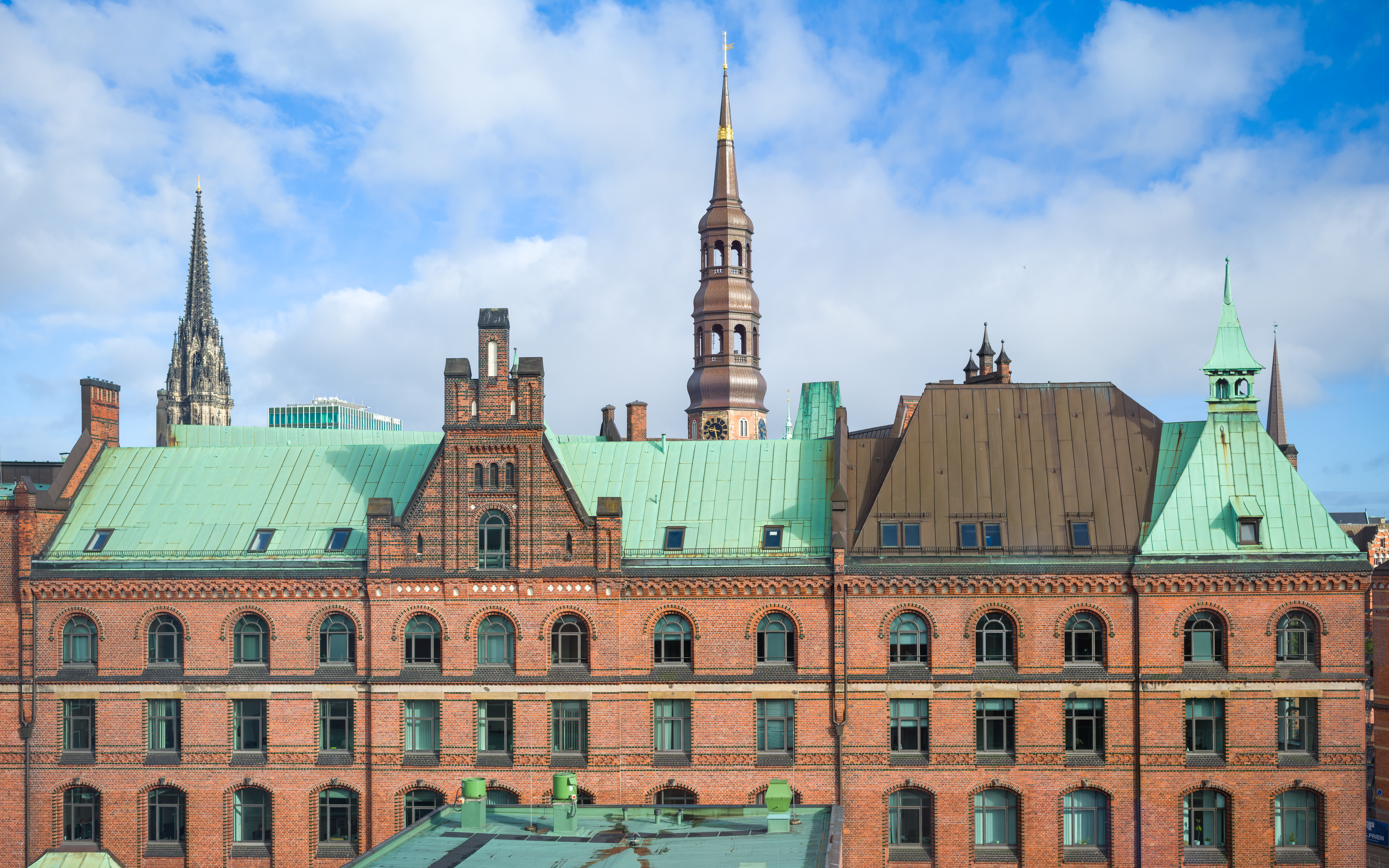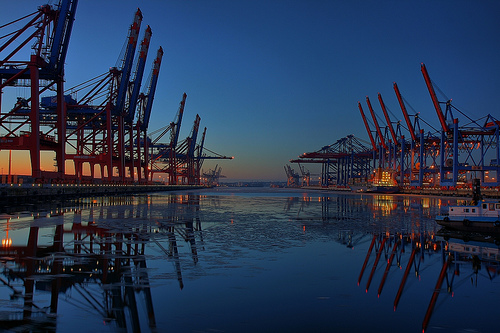|
Dradenau
Dradenau was a branch of the river Elbe near Hamburg, Germany. The name was also used for two islands created by the channel, Gros Dradenau and Klein Dradenau (Big and Little Dradenau). The islands of Dradenau were sold to Hamburg in 1445 by Count Otto von Holstein. By 1840, it was leased as private property with two farms and 66 inhabitants.C. Walther: ''Dradenau und Tradenau'', Mitteilungen des Vereins für Hamburgische Geschichte, Hamburg 1898/99, Bd. 19, S. 81 As part of the Hamburg port extensions, the Köhlfleet, another channel north of Dradenau channel, was reclaimed, which connected the islands to Waltershof, an area of Hamburg. By the late 19th century, the channel disappeared entirely due to silting and the construction of the port of Hamburg. A sewage treatment plant, Klärwerk Dradenau, currently exists where it used to flow. See also *List of rivers of Hamburg A list of rivers of Hamburg, Germany: A *Alster B *Berner Au * Bille *Bredenbek D * Deepenhorngraben * ... [...More Info...] [...Related Items...] OR: [Wikipedia] [Google] [Baidu] |
List Of Rivers Of Hamburg ...
A list of rivers of Hamburg, Germany: A *Alster B *Berner Au * Bille *Bredenbek D * Deepenhorngraben * Dove Elbe * Dradenau *Düpenau E *Elbe * Este F * Flottbek G * Glinder Au *Gose Elbe K *Köhlbrand * Kollau L * Ladenbek *Lottbek *Luruper Moorgraben M * Müllergraben N * Niederelbe *Norderelbe O *Osterbek * Ottersbek P * Pepermölenbek R * Rahlau * Reiherstieg * Rethe * Rodenbek S *Saselbek * Schillingsbek * Schleemer Bach * Seebek *Süderelbe T *Tarpenbek U *Unterelbe W *Wandse * Wedeler Au {{Lists of rivers in Germany by state Rivers Hamburg Hamburg (, ; nds, label=Hamburg German, Low Saxon, Hamborg ), officially the Free and Hanseatic City of Hamburg (german: Freie und Hansestadt Hamburg; nds, label=Low Saxon, Friee un Hansestadt Hamborg),. is the List of cities in Germany by popul ... [...More Info...] [...Related Items...] OR: [Wikipedia] [Google] [Baidu] |
Germany
Germany,, officially the Federal Republic of Germany, is a country in Central Europe. It is the second most populous country in Europe after Russia, and the most populous member state of the European Union. Germany is situated between the Baltic and North seas to the north, and the Alps to the south; it covers an area of , with a population of almost 84 million within its 16 constituent states. Germany borders Denmark to the north, Poland and the Czech Republic to the east, Austria and Switzerland to the south, and France, Luxembourg, Belgium, and the Netherlands to the west. The nation's capital and most populous city is Berlin and its financial centre is Frankfurt; the largest urban area is the Ruhr. Various Germanic tribes have inhabited the northern parts of modern Germany since classical antiquity. A region named Germania was documented before AD 100. In 962, the Kingdom of Germany formed the bulk of the Holy Roman Empire. During the 16th ce ... [...More Info...] [...Related Items...] OR: [Wikipedia] [Google] [Baidu] |
Hamburg
(male), (female) en, Hamburger(s), Hamburgian(s) , timezone1 = Central (CET) , utc_offset1 = +1 , timezone1_DST = Central (CEST) , utc_offset1_DST = +2 , postal_code_type = Postal code(s) , postal_code = 20001–21149, 22001–22769 , area_code_type = Area code(s) , area_code = 040 , registration_plate = , blank_name_sec1 = GRP (nominal) , blank_info_sec1 = €123 billion (2019) , blank1_name_sec1 = GRP per capita , blank1_info_sec1 = €67,000 (2019) , blank1_name_sec2 = HDI (2018) , blank1_info_sec2 = 0.976 · 1st of 16 , iso_code = DE-HH , blank_name_sec2 = NUTS Region , blank_info_sec2 = DE6 , website = , footnotes ... [...More Info...] [...Related Items...] OR: [Wikipedia] [Google] [Baidu] |
Elbe
The Elbe (; cs, Labe ; nds, Ilv or ''Elv''; Upper and dsb, Łobjo) is one of the major rivers of Central Europe. It rises in the Giant Mountains of the northern Czech Republic before traversing much of Bohemia (western half of the Czech Republic), then Germany and flowing into the North Sea at Cuxhaven, northwest of Hamburg. Its total length is . The Elbe's major tributaries include the rivers Vltava, Saale, Havel, Mulde, Schwarze Elster, and Ohře. The Elbe river basin, comprising the Elbe and its tributaries, has a catchment area of , the twelfth largest in Europe. The basin spans four countries, however it lies almost entirely just in two of them, Germany (65.5%) and the Czech Republic (33.7%, covering about two thirds of the state's territory). Marginally, the basin stretches also to Austria (0.6%) and Poland (0.2%). The Elbe catchment area is inhabited by 24.4 million people, the biggest cities within are Berlin, Hamburg, Prague, Dresden and Leipzig. Etymology Firs ... [...More Info...] [...Related Items...] OR: [Wikipedia] [Google] [Baidu] |
Counts Of Schauenburg And Holstein
The Counts of Schauenburg and Holstein were titles of the Frankish Empire. The dynastic family came from the County of Schauenburg near Rinteln (district Schaumburg) on the Weser in Germany. Together with its ancestral possessions in Bückeburg and Stadthagen, the House of Schauenburg ruled the County of Schauenburg and the County of Holstein. The comital titles of Holstein were subject to the liege lord, the Dukes of undivided Saxony till 1296, and thereafter the Dukes of Saxe-Lauenburg. The counties of Schauenburg and Holstein The County of Schaumburg originated as a medieval county, which was founded at the beginning of the 12th century. It was named after Schauenburg Castle, near Rinteln on the Weser, where the owners started calling themselves Lords (from 1295 Counts) of Schauenburg. Adolf I probably became the first Lord of Schauenburg in 1106. In 1110, Adolf I, Lord of Schauenburg was appointed by Lothair, Duke of Saxony to hold Holstein and Stormarn, including Hambu ... [...More Info...] [...Related Items...] OR: [Wikipedia] [Google] [Baidu] |
Waltershof
Waltershof () is a quarter in the Hamburg-Mitte borough of the Free and Hanseatic city of Hamburg in northern Germany. It is a part of the Port of Hamburg. Geography Waltershof is located at the Norderelbe and Köhlbrand and is made out of the islands Griesenwerder, Mühlenwerder, Maakenwerder and Rugenbergen. It borders the quarters Finkenwerder, Altenwerder, Steinwerder, Othmarschen, Ottensen and Altona-Altstadt. Politics In the Hamburg Parliament voting Waltershof is a part of the electoral district of Billstedt-Wilhelmsburg-Finkenwerder. Because of the very low inhabitants the voting results are combined with the results from Finkenwerder. Transportation In Waltershof is the southern entrance to the Elbe Tunnel and the western connection to the Köhlbrandbrücke. It is not connected to the public train system but it has a ferry station served by HADAG ferries to the Landungsbrücken The St. Pauli Piers (german: St. Pauli Landungsbrücken, often only referred to as '' ... [...More Info...] [...Related Items...] OR: [Wikipedia] [Google] [Baidu] |
Silting
Siltation, is water pollution caused by particulate terrestrial clastic material, with a particle size dominated by silt or clay. It refers both to the increased concentration of suspended sediments and to the increased accumulation (temporary or permanent) of fine sediments on bottoms where they are undesirable. Siltation is most often caused by soil erosion or sediment spill. It is sometimes referred to by the ambiguous term "sediment pollution", which can also refer to a chemical contamination of sediments accumulated on the bottom, or to pollutants bound to sediment particles. Although "siltation" is not perfectly stringent, since it also includes particle sizes other than silt, it is preferred for its lack of ambiguity. Causes The origin of the increased sediment transport into an area may be erosion on land or activities in the water. In rural areas, the erosion source is typically soil degradation by intensive or inadequate agricultural practices, leading to soil eros ... [...More Info...] [...Related Items...] OR: [Wikipedia] [Google] [Baidu] |
Port Of Hamburg
The Port of Hamburg (german: Hamburger Hafen, ) is a seaport on the river Elbe in Hamburg, Germany, from its mouth on the North Sea. Known as Germany's "Gateway to the World" (''Tor zur Welt''), it is the country's largest seaport by volume. In terms of TEU throughput, Hamburg is the third-busiest port in Europe (after Rotterdam and Antwerp) and 15th-largest worldwide. In 2014, 9.73 million TEUs (20-foot standard container equivalents) were handled in Hamburg. The port covers an area of (64.80 km2 usable), of which 43.31 km2 (34.12 km2) are land areas. The branching Elbe creates an ideal place for a port complex with warehousing and transshipment facilities. The extensive free port was established when Hamburg joined the German Customs Union. It enabled duty-free storing of imported goods and also importing of materials which were processed, re-packaged, used in manufacturing and then re-exported without incurring customs duties. The free port was aba ... [...More Info...] [...Related Items...] OR: [Wikipedia] [Google] [Baidu] |
Rivers Of Hamburg
A river is a natural flowing watercourse, usually freshwater, flowing towards an ocean, sea, lake or another river. In some cases, a river flows into the ground and becomes dry at the end of its course without reaching another body of water. Small rivers can be referred to using names such as creek, brook, rivulet, and rill. There are no official definitions for the generic term river as applied to geographic features, although in some countries or communities a stream is defined by its size. Many names for small rivers are specific to geographic location; examples are "run" in some parts of the United States, "burn" in Scotland and northeast England, and "beck" in northern England. Sometimes a river is defined as being larger than a creek, but not always: the language is vague. Rivers are part of the water cycle. Water generally collects in a river from precipitation through a drainage basin from surface runoff and other sources such as groundwater recharge, spring ... [...More Info...] [...Related Items...] OR: [Wikipedia] [Google] [Baidu] |
Elbe Basin
The Elbe (; cs, Labe ; nds, Ilv or ''Elv''; Upper and dsb, Łobjo) is one of the major rivers of Central Europe. It rises in the Giant Mountains of the northern Czech Republic before traversing much of Bohemia (western half of the Czech Republic), then Germany and flowing into the North Sea at Cuxhaven, northwest of Hamburg. Its total length is . The Elbe's major tributaries include the rivers Vltava, Saale, Havel, Mulde, Schwarze Elster, and Ohře. The Elbe river basin, comprising the Elbe and its tributaries, has a catchment area of , the twelfth largest in Europe. The basin spans four countries, however it lies almost entirely just in two of them, Germany (65.5%) and the Czech Republic (33.7%, covering about two thirds of the state's territory). Marginally, the basin stretches also to Austria (0.6%) and Poland (0.2%). The Elbe catchment area is inhabited by 24.4 million people, the biggest cities within are Berlin, Hamburg, Prague, Dresden and Leipzig. Etymology First ... [...More Info...] [...Related Items...] OR: [Wikipedia] [Google] [Baidu] |
Former Rivers
A former is an object, such as a template, gauge or cutting die, which is used to form something such as a boat's hull. Typically, a former gives shape to a structure that may have complex curvature. A former may become an integral part of the finished structure, as in an aircraft fuselage, or it may be removable, being using in the construction process and then discarded or re-used. Aircraft formers Formers are used in the construction of aircraft fuselage, of which a typical fuselage has a series from the nose to the empennage, typically perpendicular to the longitudinal axis of the aircraft. The primary purpose of formers is to establish the shape of the fuselage and reduce the column length of stringers to prevent instability. Formers are typically attached to longerons, which support the skin of the aircraft. The "former-and-longeron" technique (also called stations and stringers) was adopted from boat construction, and was typical of light aircraft built until the ad ... [...More Info...] [...Related Items...] OR: [Wikipedia] [Google] [Baidu] |





